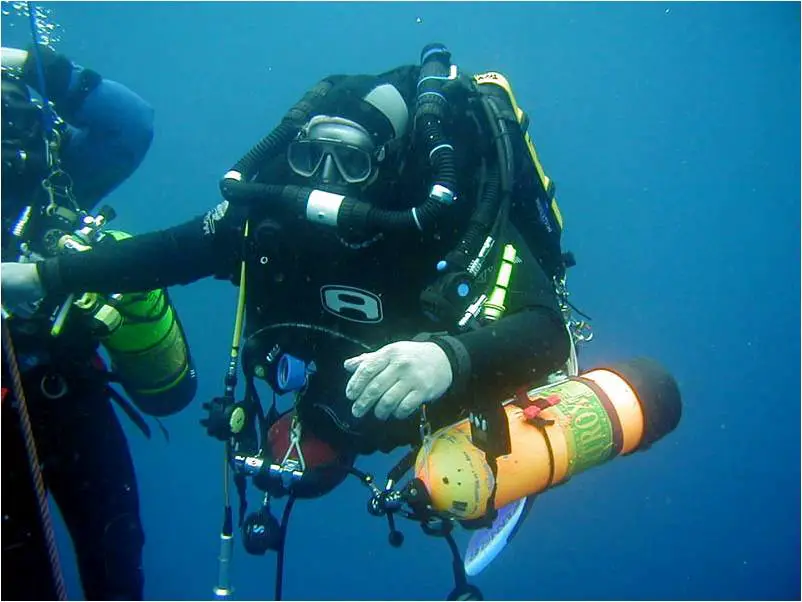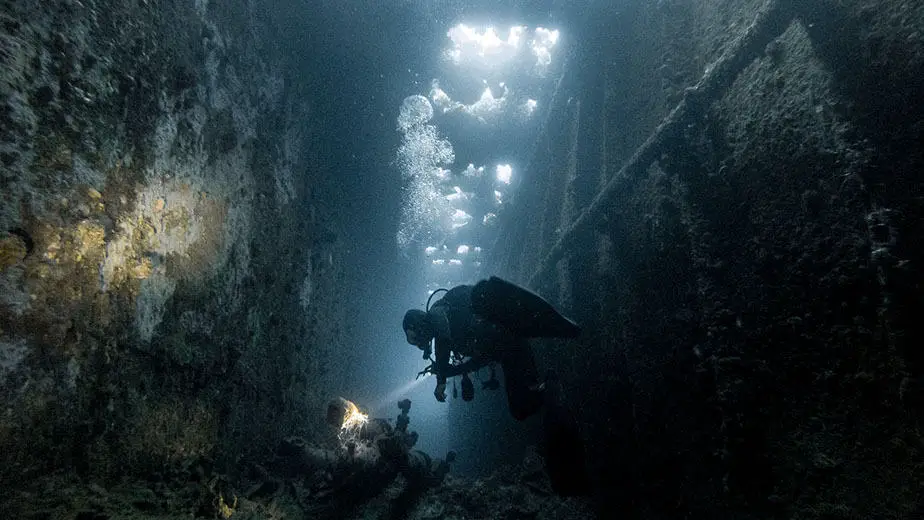Deep sea diving has various definitions depending on which diving authority you are citing. However, a very safe definition of a deep sea dive is any dive which exceeds the recreational scuba diving limit of 40 m (130 ft). This is the maximum depth that the Professional Association of Diving Instructors (PADI) considers to be the limit of recreational scuba diving.
Basically, if you need to use special gas mixes and advanced equipment such as a rebreather, there’s a good chance you’re doing a deep dive. Deep sea diving to depths of several hundred meters is typically done by commercial divers for profit, and requires logistical support and a company to cover the team’s expenses. Deep dives can also be done for scientific research purposes.
How does one become a deep sea diver?
In order to be a deep sea diver, you need to get the appropriate certifications and training experience. Before you can even attempt to take the entry-level PADI Tec 40 course which is just the starting point for technical diving, you already need to have a minimum of the Advanced Open Water, Deep Diver, and Nitrox diver certification as well as a minimum of 30 logged dives.
Taking all of these courses and logging in enough dives can take as long as 6 months or more to complete. Furthermore, it could take many years before you achieve a proficiency that will get you hired in a deep sea diving occupation. But everybody has to start somewhere, right?
Let’s start at the beginning.
Recreational scuba diving
If you’re just starting out, the first thing you need to do is get Open Water Diver certified. The most popular and widely available training agency is PADI, however you can also get certified with NAUI, SSI, and various other organizations. Here, you’ll learn all of the basics of scuba diving, which acts as a foundation for all future scuba knowledge. It is crucial that you master the basics, because advanced techniques require you to be familiar with them.
To begin, you will first be using a high-pressure scuba cylinder with a two-stage regulator so that you can breathe underwater. This type of system is open-circuit, meaning that the air you exhale is released into the water as bubbles.
As you advance, you will be introduced to closed-circuit systems known as rebreathers. When using a rebreather, the air you exhale is recycled and “cleaned up” so that you can breathe it again. Thus, little to no air is released into the water, making rebreathers very quiet.
While you can use both open-circuit and closed-circuit systems for recreational diving, the vast majority of users will use a single-tank, open-circuit setup because it is the most affordable, easy-to-use, and it gets the job done.
Once you are Open Water Diver certified, you can now dive to 18 m (60 ft), which is the entry-level recreational diving limits that equivalent certifications from other agencies adhere to. You should get a few dives under your belt before you attempt the next certification that can increase your depth limits.
Deep recreational scuba diving
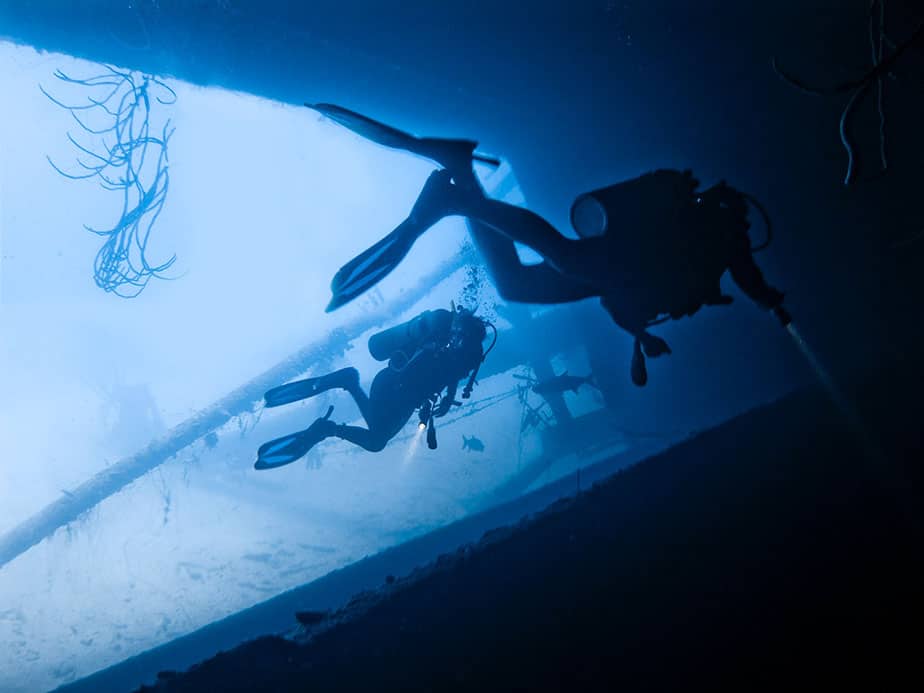
When do you get to deep sea dive? You’ll have to go through all of the recreational scuba diving training first. This allows diver training organizations to teach you these crucial skills in manageable chunks and gives students time to put these new skills to the test before they advance to the next stage.
To get past the 18 m (60 feet) limit, divers need to take an advanced course that extends their limit to 30 m (100 ft). PADI considers dives past the 18 m (60 feet) mark to be where deep recreational diving begins. Once a diver passes their Deep Diver course, they are certified to dive to 40m (130 ft) which is the limits of what most organizations consider recreational scuba diving.
Both of these courses educate divers on the increased risks involved with diving deeper and how to deal with emergencies that arise at those depths. Of particular importance is the fact that the increased water pressure at those depths will drastically reduce the no-decompression limits (NDL) and cause the gas supply to be used up quickly.
There is also the fact that they are a greater distance away from the surface should an emergency arise. Additionally, the risk of getting decompression sickness is greater and more decompression stops may be necessary in order to avoid getting bent. These factors slow down how long it takes to get to safety.
A new danger that arises during a deep dive is nitrogen narcosis, which will start to take effect at depths of 30 m (100 ft) and below. Nitrogen narcosis causes one to lose coordination and to have impaired judgment, similar to the effects of alcohol on the body. This can cause one to lose focus and ignore safety guidelines or to struggle to perform basic tasks.
It is generally accepted by the scuba community that 40 m (130 ft) is the limit which a scuba diver with the requisite certifications and training can go while still staying within their no-decompression limits.
As long as one stays within their NDL, should an emergency occur, they can ascend to the surface without doing any decompression stops, however they should still stay under the maximum ascent rate of 9 meters per minute and perform a 3 minute safety stop around the 3-5 meter mark before surfacing. This will help prevent the deadly effects of decompression sickness.
Should a diver exceed their NDL, they must perform various decompression stops during the ascent. A diver should never accidentally exceed their NDL. Decompression diving should be intentional, otherwise it can be panic-inducing being forced to stop so many times with a dwindling gas supply.
Dives that exceed the NDL and depth limits can be considered a technical dive, and yes, there are courses that train and equip divers with the skills to handle them.
Technical diving
Often shortened to tec diving, technical diving allows divers to surpass the standard recreational diving limits of depth and NDL. It also involves training to dive in overhead environments such as caves or wrecks. Once you’ve reached the stage where you are doing tec diving, you have truly reached the point where you are doing non-professional, deep sea diving.
To get to that point, however, requires even more training and specialized equipment to help you perform these dives safely. If you are not properly trained or using the appropriate gear and you decide to dive deeper than your certification allows, you are not a tec diver; you are just irresponsible and have a death wish.
The training required for tec diving is extremely demanding, and diving to deeper depths is done one step at a time. After all, the risk increases for every 10m that you dive (the water pressure increases by 1 atmosphere, and the effects of nitrogen narcosis worsens), so divers must spend some time at each new depth to gain experience and check on their well-being.
There is an emphasis on practicing what to do in the event of an emergency so that, in the heat of the moment, tec divers can still follow procedure without panicking or fumbling. Each tec dive is meticulously planned, with back-up plans ready to be executed if plan A fails.
As you’d expect, technical diving is very… technical. For instance, the steps to decompress from a tec dive can be very confusing even to a recreational diver. For instance, a tec diver may need to perform a series of decompression stops at planned depths for a fixed period of time while changing the gas mix used in order to prevent decompression sickness. A dive computer can simplify this process.
Even with technical diving, a suitably equipped and proficient scuba diver can already dive to extreme depths. When executed properly, technical dives can let you explore large caverns, deep shipwrecks, or popular diving destinations that no other diver has gone before.
Commercial diving
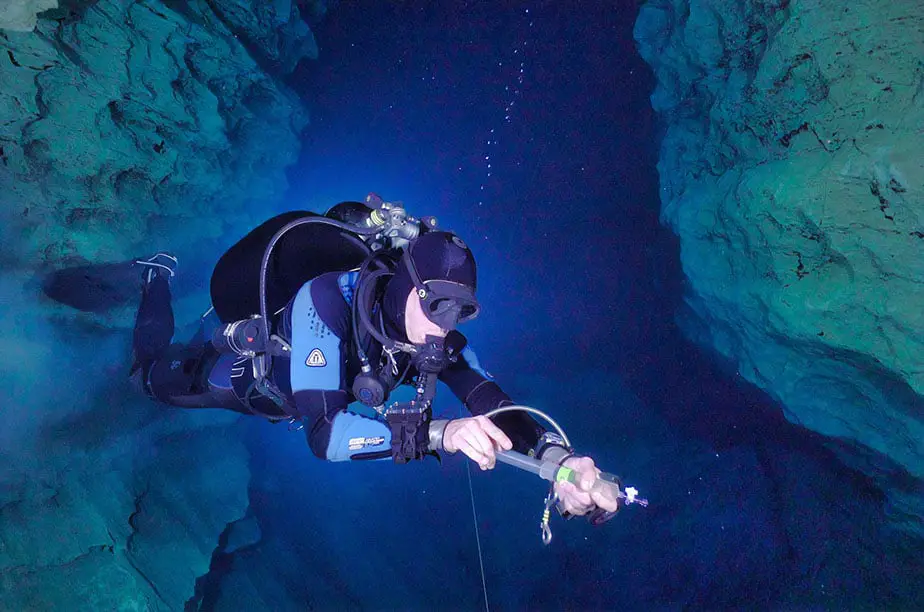
Commercial diving is technical diving taken to the extreme. It is probably what the lay-person imagines when they think “deep sea diving.” Typically, commercial diving is done when it is not possible or worth the cost of deploying a Remotely Operated Vehicle (ROV). A commercial diver might do research, perform inspections, repairs, and cleaning. This is very common in the off-shore oil industry as well as in the scientific community.
For shallower work, commercial divers will either dive down like normal or be lowered down by a lift of some sort. For deeper work that exceeds the decompression limits and requires significant underwater time, divers may rely on a submersible diving bell that carries them down to depth and lets them exit the water to rest while remaining pressurized.
Another type of commercial deep sea diving is saturation diving. This is when the divers remain at depth working for so long that they reach a pressure equilibrium with the water pressure at the depth they are working at (saturated with inert gases).
Saturation divers basically live underwater, resting in dry chambers that can be lifted back to the surface while remaining pressurized between work periods. Once the job is complete, these divers can finally return to the surface for a controlled, slow decompression.
In addition to industrial work, there are other types of commercial diving, such as research diving, military diving, public safety diving, and underwater filming.
How deep can deep sea divers dive?
Recreational and technical diving
Most training agencies recommend similar guidelines for maximum depths achievable with which certifications. If you plan on diving using only regular air, then you should dive no further than 50 m (160 feet).
Any deeper than this, then it is recommended that divers use a trimix gas supply. Trimix adds helium to the breathing gas which does not cause nitrogen narcosis unlike regular air. Thus, divers can dive deeper without being affected as much by nitrogen narcosis’ impairing effects, helping them to maintain their state of mind and dexterity.
Divers using trimix can reach depths of 100 m (330 ft) and beyond, even as a “hobby” technical diver with the appropriate equipment and training. The only limitation for technical diving is the diver’s experience and physiology.
Commercial diving
With a large company’s near unlimited resources, commercial divers can reach impossible depths far out of the reach of recreational and tec divers.
Special gas mixes and access to equipment like long-term underwater work habitats allow commercial divers to stay underwater for weeks at a time at depths of 20 m (65 ft) all the way to 305 m (1000 ft).
Furthermore, there are specialized atmospheric diving suits that allow divers to reach depths of 700m (2,300 ft) underwater. As technology advances and even deeper dives are required, instead of relying on human divers, deep commercial diving will likely be replaced by Remotely Operated Vehicles.
Recreational diving vs. deep sea diving
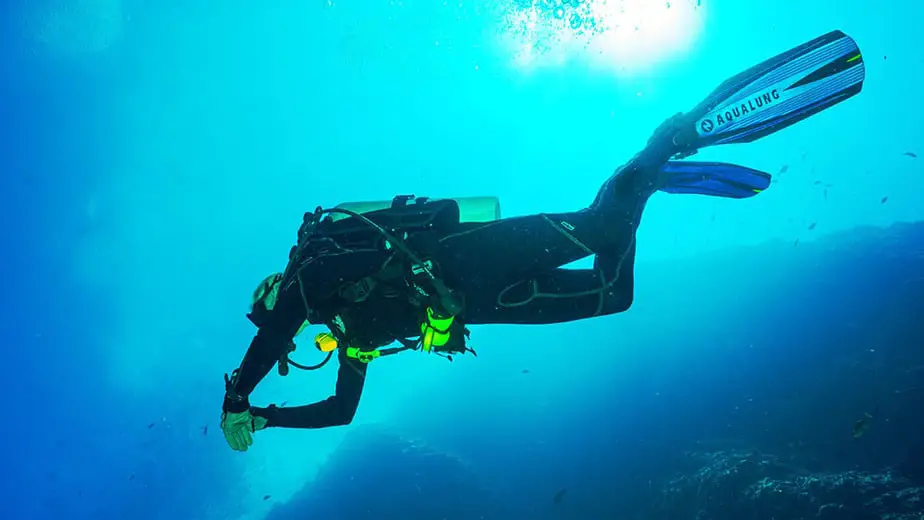
Divers who have mastered recreational diving and want a new experience can further their diving education and improve their skills by pursuing technical diving. The continual effort to learn the skills needed for tec diving, as well as to maintain them, is a challenge all its own.
Yet, many divers love the journey and want more opportunities to dive in exciting environments. As their passion grows, they will acquire new equipment, learn new techniques, and refine old ones. Deep sea diving is just another step in your scuba journey, just like it was when you took the leap to go from non-diver to Open Water Diver.
With technical diving, divers can dive much deeper and for longer than the traditional single tank, open-circuit setup in new locations that they couldn’t access before.
There are several very clear differences between recreational diving and deep sea diving which we cover below.
Depth Limits
The maximum depth of recreational diving is 40 m (130 ft) and this can be achieved relatively easily. At this point, you can still use the traditional scuba equipment and don’t need to use special equipment or gas mixes yet.
When it comes to deep sea (technical) diving, the maximum depth that is achievable depends on the diver’s experience, training, and individual physiology. They will be subjected to intense pressure and nitrogen narcosis.
Technical dives have been made as deep as 300 m (985 feet), however few individuals in the world can do this, and significant preparation, training, and multiple gas tanks are needed to achieve this.
For commercial diving, divers wearing resilient atmospheric diving suits that can withstand intense water pressure have made dives as deep as 700 m (2,300 ft).
Training
While it’s possible to get Open Water Diver certified in less than a week, the training required for technical and commercial diving can take months just to get your foot in the door, and years to actually be good enough to reach the deepest levels or to get your foot in the door at a company that needs deep sea divers.
Gas mixes
For recreational diving, a single tank containing normal compressed air is all that’s required. For tec and commercial diving, divers need to use specialized gas mixes carefully selected to prevent oxygen toxicity and nitrogen narcosis at deep depths.
Equipment
Most recreational scuba divers will dive with a single tank of air, two-stage regulator, BCD, a dive computer, fins, and wetsuit. If they need help, they can signal to their dive buddy.
Tec and commercial divers typically dive alone and bring back-up equipment so that they can deal with the situations themselves. They may also use a rebreather which recycles air and allows divers to stay underwater for much longer than a regulator can.
Decompression
Recreational scuba divers typically stay within their no-decompression limits so that they can surface relatively quickly in case of an emergency.
On the other hand, tec and commercial deep divers exceed their NDL and must perform decompression stops at various depths to give their body time to off-gas the excess nitrogen in their system in order to avoid decompression sickness.
Parting Words
As you can see, there are major differences between traditional scuba diving and deep sea diving. Whether you are doing technical or commercial diving, deep sea diving is a risky activity that requires extensive training and specialized equipment to even attempt.
With that said, deep sea diving can be a fascinating career or a deeply rewarding hobby as long as each dive is carefully planned and executed perfectly. For those willing to put forth the time, money, and effort to get properly trained for deep sea diving, then you will be able to dive in exclusive locations that literally nobody else in the world has ever visited before.
Photo Credits: Lyn Turner, CC BY-SA 3.0

